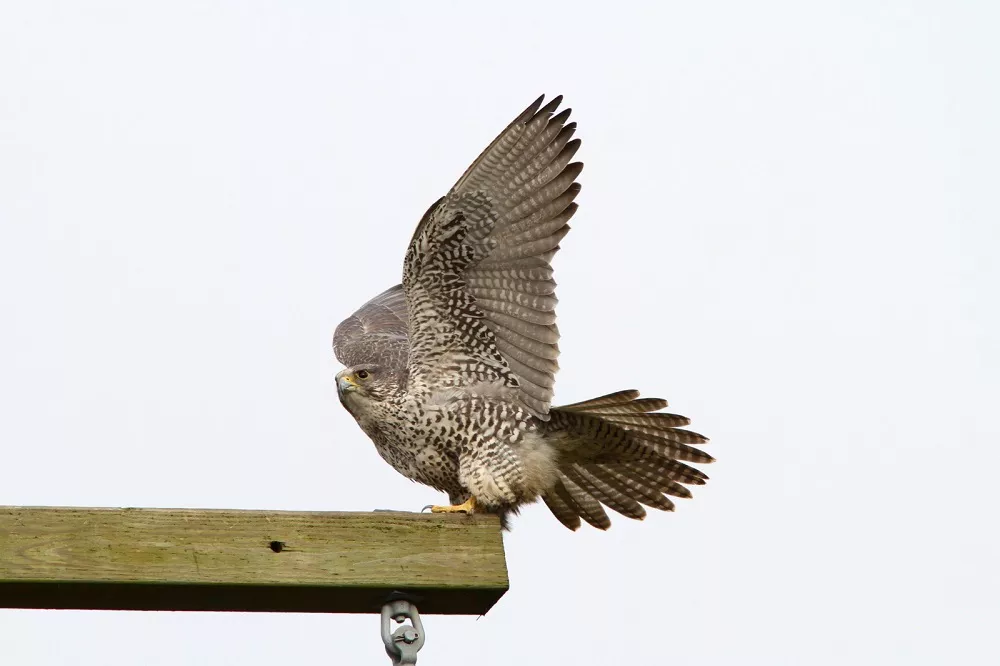The Gyrfalcon (Falco rusticolus) , also known as the “arctic falcon,” is a large bird of prey found in the Arctic and sub-Arctic regions of North America, Europe, and Asia. This majestic bird is highly prized by falconers and has played an important role in human history for thousands of years. In this article, we will explore the characteristics, behavior, and cultural significance of the gyrfalcon.
Physical Characteristics
The Gyrfalcon is the largest falcon species in the world,, with a wingspan of up to 63 inches (160 cm) and a weight of up to 3.5 pounds (1.6 kg). It is slightly larger than the peregrine falcon, which is often considered the fastest bird in the world. The gyrfalcon has a distinctive white or light-colored head, with dark brown or black feathers on its back and wings, white feathers on its underbelly, and a barred pattern on its chest. Gyrfalcons possess powerful hooked beaks, sharp talons, and keen eyesight, making them formidable predators in the avian world.
Habitat and Range
The Gyrfalcon is an inhabitant of the Arctic and subarctic regions, with its range spanning across the northern parts of North America, Europe, and Asia. It is most commonly found in areas such as Greenland, Iceland, northern Canada, Scandinavia, and Siberia. This species showcases remarkable adaptations that enable it to thrive in the frigid environments and open tundra landscapes of its habitat. During the summer breeding season, they inhabit cliffs and rocky outcrops, where they build their nests. In the winter, they move to more open areas and hunt for prey across the snow-covered landscape.
Diet and Hunting Techniques
The Gyrfalcon is a formidable predator, hunting a variety of prey such as ptarmigan, grouse, ducks, and even other birds of prey. They are also known to take down mammals like hares and squirrels. Their hunting techniques vary depending on the target, ranging from flight pursuit to ambush tactics.
The Gyrfalcon is highly skilled hunters, preying on a variety of avian species, primarily in flight. Their hunting techniques are adapted to their Arctic habitat. They employ two primary strategies: “stooping” and “contour-hunting.” Stooping involves a high-speed dive from great altitudes, reaching speeds of up to 130 mph (209 km/h), to capture unsuspecting prey in mid-air. Contour-hunting involves flying low and using the terrain for cover to surprise prey. These strategies enable the Gyrfalcon to target a wide range of prey, including ptarmigans, ducks, grouse, seabirds, and even hares.
Cultural Significance
The gyrfalcon has played an important role in human history, particularly in the cultures of the Arctic and sub-Arctic regions. For thousands of years, indigenous peoples have used the gyrfalcon for hunting and as a symbol of power and strength. In medieval Europe, the gyrfalcon was highly prized by royalty and nobility for use in falconry, a sport in which trained birds of prey are used to hunt wild game. The gyrfalcon was considered the ultimate prize for falconers, and its capture and training were highly specialized arts.
Conservation Status
While the gyrfalcon is not currently considered to be at risk of extinction, it is protected by law in many countries, including the United States, Canada, and Russia. Habitat loss, climate change, and hunting continue to pose threats to the gyrfalcon population, however, and conservation efforts are ongoing to protect this magnificent bird.
In conclusion, the gyrfalcon is a fascinating and highly respected bird of prey, prized for its speed, power, and beauty. Its role in human history and culture, as well as its important ecological niche in the Arctic and sub-Arctic regions, make it a bird worthy of admiration and protection.


 Facebook
Facebook  Instagram
Instagram  Youtube
Youtube 